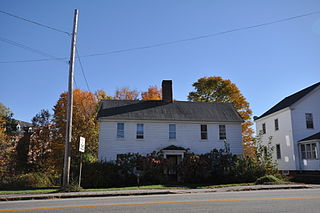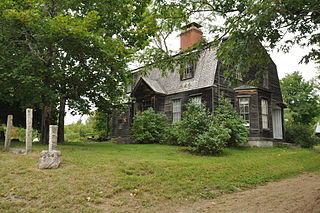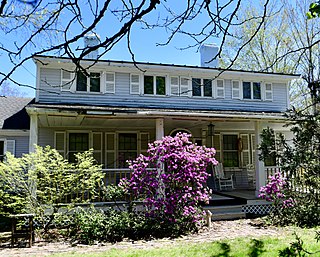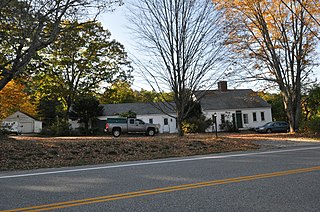
The Benjamin Cleaves House is a historic house on South High Street in Bridgton, Maine, United States. Built in 1828, it is a well-preserved late example of Federal period architecture, and is most notable for the murals drawn on its walls, probably by the itinerant artist Rufus Porter. The house was listed on the National Register of Historic Places in 1988.

The Black Horse Tavern is an historic tavern on Searsport Avenue in Belfast, Maine. Built in 1795, it was the city's first tavern located on the eastern side of the Passagassawakeag River, and is a well-preserved example of vernacular Federal period architecture. The building, now a private residence, was added to the National Register of Historic Places in 1982.

The Lt. Robert Andrews House is an historic house at 428 South Bridgton Road in Bridgton, Maine, United States. Built in 1805 by John Kilborn, Jr., a local master builder, it was the home for many years of Robert Andrews, a veteran of the American Revolutionary War and an early settler of the Bridgton area. The house was listed on the National Register of Historic Places in 2005.
The Benjamin C. Wilder House is an historic house at 1267 Main Street in Washburn, Maine. Built about 1852, it is a well-preserved example of mid-19th century vernacular architecture in northern Aroostook County, built in the first decade after widespread settlement began of the area. The house was listed on the National Register of Historic Places in 1987. It is now owned by the local Salmon Brook Historical Society and operated as a historic house museum.

The Deacon Samuel and Jabez Lane Homestead is a historic farmstead at 132 Portsmouth Avenue in Stratham, New Hampshire. Built in 1807, the main house is a fine local example of Federal period architecture, with carvings executed by a regional master craftsman. The property is further significant because the owners at the time of its construction kept detailed journals documenting the construction of it and other buildings on the property. The property was listed on the National Register of Historic Places in 1983.

The Barrows-Steadman Homestead is a historic house at the northeast corner of Main and Stuart Streets in Fryeburg, Maine, United States. Built c. 1809, this frame house is a good vernacular example of Federal architecture, but is most notable for the murals painted on the walls of one of its bedrooms by Rufus Porter and Jonathan Poor, noted itinerant painters of the 19th century. The house was listed on the National Register of Historic Places in 1982.

The Cornet Thomas Wiggin House is a historic house at 249 Portsmouth Avenue in Stratham, New Hampshire. Probably built in the 1770s, it is a remarkably little-altered example of vernacular Federal period architecture. It was listed on the National Register of Historic Places in 1983.

The Holmes-Crafts Homestead is a historic house at the southern junction of Old Jay Hill Road and Main Street in Jay, Maine. Built in the early 19th century, it is a well-preserved local example of Federal architecture, and was home to James Starr, one of the first settlers of the area and a prominent local lawyer and politician. The building, now owned by the local historical society, was listed on the National Register of Historic Places in 1973.

The McCleary Farm is a historic farm complex on South Strong Road in Strong, Maine. Probably built sometime between 1825 and 1828, the main house is a fine local example of Federal style architecture. It is most notable, however, for the murals drawn on its walls by Jonathan Poor, an itinerant artist active in Maine in the 1830s. The property was listed on the National Register of Historic Places in 1989.
The George W. Smith Homestead is a historic house on Main Street in Mattawamkeag, Maine. Built in 1874 by the son of one of the town's early settlers, the Italianate-style house is the only house of significant architectural merit in the small community. It was listed on the National Register of Historic Places in 1980.

The Grant Family House is a historic house at 72 Grant Street in Saco, Maine. Built in 1825, the house is a fine local example of Federal period architecture, but is most notable for an extensive series of well-preserved stenciled artwork on the walls of its hall and main parlor. The house was listed on the National Register of Historic Places in 1990.

The Thomas Hobbs Jr. House is a historic house on Wells Street in North Berwick, Maine. Built in 1763, it is one of the town's oldest surviving houses, and was for many years a tavern and social center of the community. it was listed on the National Register of Historic Places in 1982.
The Weston Homestead is a historic house on Weston Road in Madison, Maine. Built in 1817, it is remarkably fine and well-preserved example of Federal period architecture. The many generations of Westons who have owned have a history of civic involvement in the community. The house was listed on the National Register of Historic Places in 1977.

The Libby-MacArthur House is a historic house at 294 Sokokis Avenue in the center of Limington, Maine. Believed to have been built about 1794, it is the only surviving house of one of the town's earliest permanent residents, and is a rare example in the state of a Federal period house with a gambrel roof. It was listed on the National Register of Historic Places in 1988.

The Moody Homestead is a historic house at 100 Ridge Road in York, Maine. The main house, built in 1790, is attached to an ell that is estimated to date to the late 17th century. The house has been owned by descendants of the locally prominent Moody family since the 1770s. It was listed on the National Register of Historic Places in 1975.
The Hezekiah Chase House is a historic house in United States Route 202 in the center of Unity, Maine. Built in 1826, it is a high-quality example of Federal architecture executed in brick. It is also notable as the birthplace of George Colby Chase, the second president of Bates College. The house was listed on the National Register of Historic Places in 1978.

Watchtide by the Sea, once known as the College Club Inn, is a historic traveler accommodation at 190 West Main Street in Searsport, Maine. Based around an early 19th-century house and developed as an inn and tea room in the early 20th century, the property exemplifies the adaptive reuse of older properties for the tourist trade in Maine. It was listed on the National Register of Historic Places in 2000.

The Smith–Emery House is a historic house at 400 Main Street in the Springvale village of Sanford, Maine. Built in 1847, it is one of Sanford's largest and finest examples of Greek Revival architecture, and was owned by two prominent local businessmen. It was listed on the National Register of Historic Places in 1998.

The Freeman Farm Historic District encompasses a historic farm property in Gray, Maine. The 100-acre (40 ha) parcel, originally platted out in 1791, was owned and operated by five generations of the Freeman family, and is emblematic of the changes in agricultural practices over a period of more than 150 years. It was listed on the National Register of Historic Places in 2003.
The Hussey–Littlefield Farm is a historic farmstead at 63 Hussey Road in Albion, Maine. Developed between about 1838 and 1905, the farm's connected homestead exhibits the evolutionary changes of rural agricultural architecture in 19th-century Maine. The farmstead was listed on the National Register of Historic Places in 2016.

















